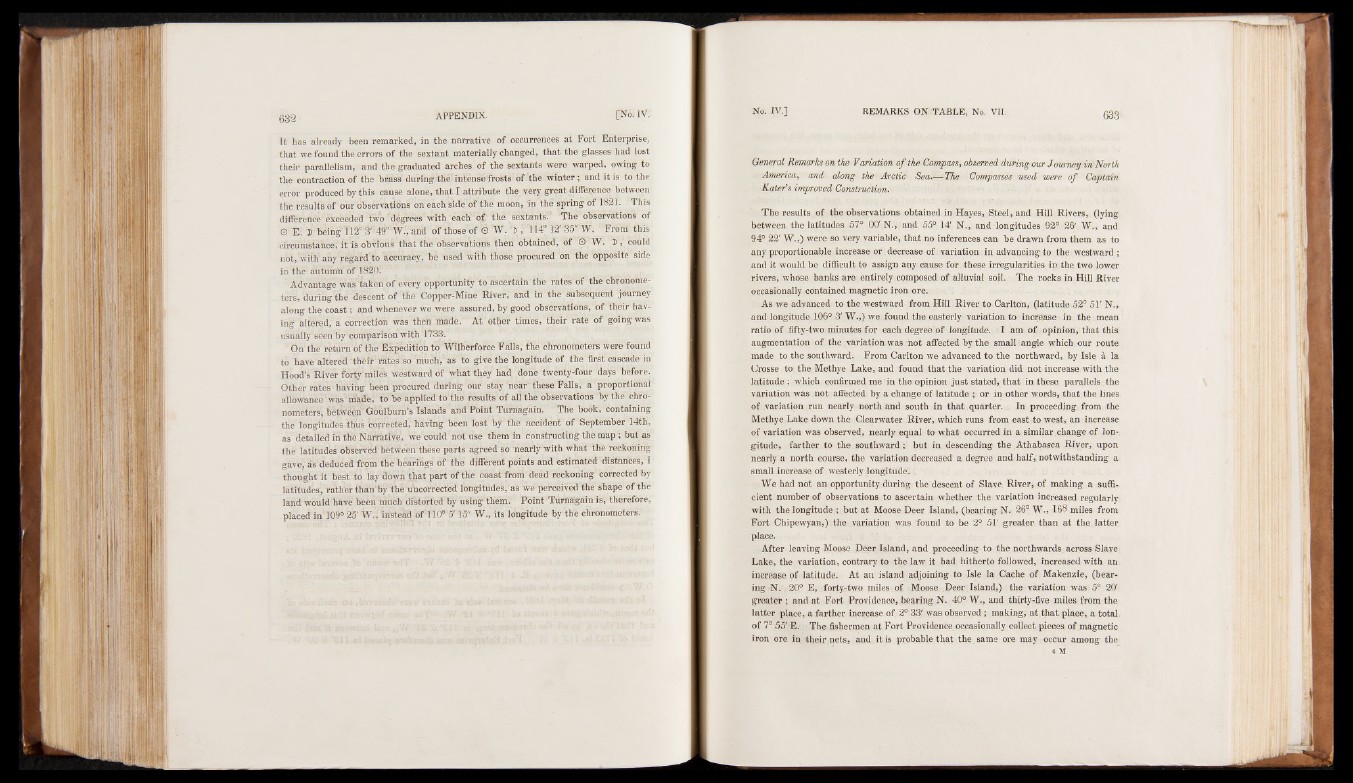
It has already been remarked, in the narrative of occurrences at Fort Enterprise,
that we found the errors of the sextant materially changed, that the glasses had lost
their parallelism, and the graduated arches of the sextants were warped, owing to
the contraction of the brass during the intense frosts of the winter; and it is to the
error produced by this cause alone, that I attribute the very great difference between
the results of our observations on each side of the moon, in the spring of 1821. This
difference exceeded two 'degrees with each of; the sextants. The observations of
G) E. 3) béihg 112° 3'' 49" W:, and of those of O 'W. ‘ï ; 114° 12' 35"‘W. From this
circumstance/ it is obvious that the observations then obtained, of O W. D , could
not, with' aiiy! regard to accuracy, be used with those procured on the opposite Side
in the- autumn of 1820:
Advantage was taken of every opportunity to ascertain the rates of the chronometers,
during the descent of the Copper-Mine Rivet, and in the“ subsequent journey
along the coast; and whenever we were assured, by good observations, of their having
altered, a correction was then made. At other times, their rate of goingwas
usually seen by comparison with 1738V ?
On the return of the Expedition to Wilberforce Falls, the chronometers were found
to havé'altered‘thêif rates so much, as to give the longitude of the first cascade in
Hood’s River forty'miles westward of what they had doiie twenty-four days before.
Other rates havifig been procured during our stay near these Falls, a proportional
allowance was' made,' to be applied to the results óf all the observations by the Chronometers,
bétWéén ' Gbulburn’s Islands and Point Turnagain. The book, containing
the longitudes th'us corrected, having been lost by the accident of September 14th,
as detailed in the Narrative, we'could not use them in constructing the map ; but as
the latitudes observed1 bëtwéén these parts agreed so nearly with what the reckoning
gave, as deduced frpm tfie-bearings of the different points and estimated distances, I
thought it best to lay down that part of the coast from dead reckoning corrected by
latitudes, rather than by the uncoVrectéd longitudes, as wé perceived the shape of the
land would have been much distorted by using them. Point Turnagain is, therefore,
placed in 109° 25' W., instead óf T10° 5' 15'' W., its longitude by the chronometers.
General Remarks on the Variation of the Compass, observed during our Journey in North
America, and along the Arctic Sea.— The Compasses used were of Captain
Rater's improved Construction.
The results of the observations obtained in Hayes, Steel, and Hill Rivers, (lying
between the latitudes 57° 00' N., and 55° 14' N., and.longitudes 92° 26'. W., and
94° 22' W.,) were so very variable, that no inferences can be drawn from them as to
any proportionable, increase or decrease of variation in advancing to the westward ;
and it would be difficult to assign any cause for these irregularities in the two lower
rivers, whose banks are entirely composed of alluvial soil. The rocks in Hill River
occasionally contained magnetic iron ore.
As we advanced to the westward from Hill River to Carlton,.(latitude 52° 51' N.,
and longitude 106° 3' W.,) we found the easterly variation to increase in the mean
ratio of fifty-two minutes for each degree of longitude. I am of opinion, that this
augmentation of the variation was not affected by the small angle which our route
made to the southward. From Carlton we advanced to the northward, by Isle & la
Crosse to the Methye Lake, and found that the variation did not increase with the
latitude ; which confirmed me in the opinion just stated, that in these parallels the
variation was not affected by a change of latitude ; or in other words, that the lines,
of variation run nearly north and south in that quarter. In proceeding from the.
Methye Lake down the Clearwater River, which runs from east to west, an increase
of variation was observed, nearly equal to what occurred in a similar change of longitude,
farther to the southward; but in descending the Athabasca River, upon
nearly a north course, the variation decreased a degree and half, notwithstanding a
small increase of westerly longitude. .
We had not an opportunity during the descent of Slave. River, of making a sufficient
number of observations .to ascertain whether the variation increased regularly
with the longitude ; but at Moose Deer Island, (bearing N. 26° W*> 168 miles from
Fort Chipewyan,) the variation was found to be 2°, 51' greater than at the latter
place.
After leaving Moose Deer Island, and proceeding to the northwards across Slave
Lake, the variation, contrary to the law it had hitherto followed, increased with an
increase of latitude. At an island adjoining to Isle la Cache of Makenzie, (bearing
N. 20° E, forty-two miles of Moose Deer Island,) the variation was . 5P 2(y
greater ; and at Fort Providence, bearing N. 40° W., and thirty-five miles from the
latter place, a farther increase of 2° 33' was observed; making, at that place, a total
of 7° 55' E. The fishermen at Fort Providence occasionally collect pieces of magnetic
iron ore in their nets, and it is probable that the same ore may occur among the
4 M